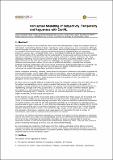Por favor, use este identificador para citar o enlazar a este item:
http://hdl.handle.net/10261/209522COMPARTIR / EXPORTAR:
 SHARE
BASE SHARE
BASE
|
|
| Visualizar otros formatos: MARC | Dublin Core | RDF | ORE | MODS | METS | DIDL | DATACITE | |

| Título: | Conceptual Modelling of Subjectivity, Temporality and Vagueness with ConML |
Autor: | González-Pérez, César CSIC ORCID ; Martín-Rodilla, Patricia CSIC ORCID | Fecha de publicación: | 8-jul-2019 | Citación: | Digital Humanities Conference (2019) | Resumen: | Research and practice in the humanities often involve the management of large and complex bodies of information representing objects of study, hypotheses, work in progress or even conclusions. Although natural language is usually employed to convey these, semi-formal languages have shown to be useful in a number of situations due to reduced ambiguity and ease of implementation on computing platforms (CIDOC, 2011; Gonzalez-Perez, 2012). Conceptual modelling, the technique to construct semi-formal models of the world that can be understood by humans and machines, is thus an excellent approach to fight the complexity that very often makes humanities a difficult endeavour. By using conceptual modelling, we can explore unknown areas of research, document entities in the world for latter reference (in the form of inventories or catalogues, for example), communicate complex situations and processes to others (in our own or a different discipline), prescribe how computer systems should be constructed (very much like an architectural drawing prescribes how a building is to be built), and facilitate the interoperation of heterogeneous bodies of data through the gradual refinement of models (Gonzalez-Perez and Martín-Rodilla, 2015). Within conceptual modelling, however, some areas are still poorly understood and weakly supported by existing technologies. One of these areas is that of “soft issues”, that is, the modelling of issues that are crucial to human understanding, but which have been traditionally regarded as incompatible with or almost intractable by computers. Some examples include the passage of time, the subjective perception of the world, and vagueness. As these issues are usually difficult to implement as part of computer systems, they are often left out of formalised representations, which results in models that become too simplistic to be useful. For example, very few databases in the humanities are capable of recording information diachronically (i.e. representing changes over time), subjectively (i.e. recording the voices of different relevant agents) and vaguely (i.e. acknowledging that the world is not clear-cut, and that fuzzy boundaries and imperfect knowledge exist). However, soft issues are a crucial component of research and practice in digital humanities, so they should not be left out. In this tutorial, we use ConML (www.conml.org) to demonstrate how these issues can be tackled, and how conceptual models can be constructed that express temporality, subjectivity and vagueness. ConML is a conceptual modelling language developed with a special orientation towards the humanities and social sciences, and with the aim that specialists with little or no experience in computer science would be able to learn it and use it in very little time (Gonzalez-Perez and Martín-Rodilla, 2017). ConML has been successfully used in a number of projects, such as the development of the Cultural Heritage Abstract Reference Model (CHARM, www.charminfo.org) (Incipit, 2016). Specifically, ConML supports the expression of temporal, subjective and vague aspects of information through a number of mechanisms, which will be presented and exercised in the tutorial. The tutorial will employ theoretical explanations combined with hands-on group exercises, a technique that we have been since 2012 in our postgraduate courses on information modelling for the humanities at the University of Santiago de Compostela. Attendees will acquire practical skills to construct expressive models, as well as the theoretical underpinnings supporting them. They will have access to proven modelling techniques as well as new and experimental findings. By incorporating the modelling of soft issues into their toolbox, attendees will be able to construct conceptual models that document the object of study much better, communicate intentions in a richer manner, and allow the implementation of computer systems capable of catering for these complex but essential aspects of the humanistic inquiry. | Descripción: | Trabajo presentado en la Digital Humanities Conference, celebrada en Utrech (Países Bajos), del 8 al 12 de julio de 2019 | Versión del editor: | https://dev.clariah.nl/files/dh2019/boa/1049.html | URI: | http://hdl.handle.net/10261/209522 |
| Aparece en las colecciones: | (INCIPIT) Comunicaciones congresos |
Ficheros en este ítem:
| Fichero | Descripción | Tamaño | Formato | |
|---|---|---|---|---|
| Conceptual Modelling_GonzalezPerez.pdf | 149,29 kB | Adobe PDF |  Visualizar/Abrir |
CORE Recommender
Page view(s)
141
checked on 19-abr-2024
Download(s)
89
checked on 19-abr-2024
Google ScholarTM
Check
NOTA: Los ítems de Digital.CSIC están protegidos por copyright, con todos los derechos reservados, a menos que se indique lo contrario.
